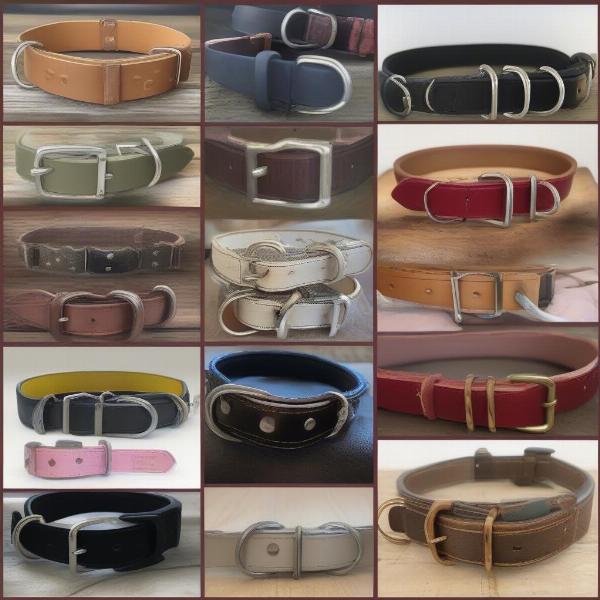Pig dog collars are essential tools for dog owners involved in pig hunting or similar activities. These specialized collars are designed to protect the dog’s neck and throat during encounters with wild pigs, providing a crucial layer of defense against tusk injuries. This guide will cover everything you need to know about pig dog collars, from selecting the right type to proper maintenance.
Choosing the Right Pig Dog Collar
 Choosing a pig dog collar for your hunting dog
Choosing a pig dog collar for your hunting dog
Selecting the appropriate pig dog collar is paramount for your dog’s safety. Consider the following factors: material, fit, and buckle type. Common materials include leather, Kevlar, and various synthetics. Leather offers traditional durability, while Kevlar and synthetics provide enhanced protection against sharp tusks. A proper fit is crucial – the collar should be snug but not restrictive, allowing two fingers to fit comfortably beneath. Buckles should be strong and reliable, capable of withstanding intense pressure. For a deeper dive into dog nutrition, see our article on tripe for dogs.
Materials: Leather vs. Synthetic vs. Kevlar
Leather pig dog collars are a classic choice, offering a blend of durability and comfort. However, they can be susceptible to damage from moisture and pig saliva. Synthetic collars are often more resistant to these elements and offer a wider range of colors and designs. Kevlar, the material used in bulletproof vests, provides the highest level of puncture resistance, making it an ideal choice for dogs facing particularly aggressive pigs.
Sizing and Fit: Ensuring Comfort and Protection
Measuring your dog’s neck accurately is essential for a proper fit. Use a flexible tape measure and measure around the widest part of the neck, allowing for two fingers to fit comfortably beneath the tape. A collar that’s too loose can be ineffective, while a collar that’s too tight can restrict breathing and cause discomfort.
Caring for Your Pig Dog Collar
Regular maintenance will extend the life of your pig dog collar and ensure its effectiveness. After each use, rinse the collar thoroughly to remove dirt, debris, and pig saliva. Leather collars should be conditioned regularly to prevent drying and cracking. Inspect the collar frequently for signs of wear and tear, such as fraying, cuts, or weakened buckles. Replace the collar if you notice any significant damage. If you are interested in dog breeds with unique coat colors, you can explore our article about the sable colour dog.
Training with a Pig Dog Collar
Introducing your dog to a pig dog collar should be a gradual process. Start by allowing your dog to wear the collar for short periods during training sessions. Gradually increase the duration as your dog becomes more comfortable. This allows the dog to associate the collar with positive experiences and prevents any anxiety or discomfort. Are you also interested in other types of specialized dog collars? You might find our article on tennessee dog collar helpful.
Conclusion
Investing in a high-quality pig dog collar is a crucial step in ensuring your dog’s safety and well-being during pig hunting activities. By carefully considering the factors discussed in this guide, you can select the perfect collar to provide optimal protection and comfort for your canine companion. Remember, a well-maintained pig dog collar is an investment in your dog’s long-term health and performance. Thinking of adding a new dog to your family? Visit our website to learn more about suitable dog breeds and check out the black dog ranch.
FAQ
- What is the best material for a pig dog collar? Kevlar offers the highest level of puncture resistance, but leather and synthetic materials can also provide adequate protection depending on the hunting environment.
- How often should I clean my dog’s pig collar? Clean the collar thoroughly after each use to remove dirt, debris, and pig saliva.
- How do I know if my dog’s pig collar fits correctly? You should be able to fit two fingers comfortably between the collar and your dog’s neck.
- Can I use a regular dog collar for pig hunting? No, regular dog collars are not designed to protect against pig tusks and can be easily damaged.
- Where can I buy a pig dog collar? Specialized hunting supply stores and online retailers often carry a variety of pig dog collars.
- How do I introduce my dog to a pig dog collar? Gradually introduce the collar during training sessions, starting with short periods and increasing the duration as your dog becomes comfortable.
- What should I do if my dog’s pig collar is damaged? Replace the collar immediately if you notice any significant signs of wear and tear.
About ILM Dog
ILM Dog is your trusted international resource for expert dog care advice, breed information, health tips, training guidance, nutrition plans, and a curated selection of premium dog products and accessories. Whether you’re a seasoned dog owner or just starting your journey, we provide practical, evidence-based information to help you nurture your canine companion’s well-being. For personalized guidance or any inquiries, contact us at [email protected] or call us at +44 20-3965-8624. Visit ILM Dog today to learn more.